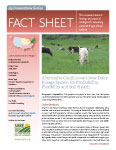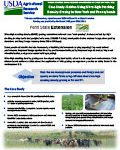Forage Quality, Testing, Species, Varieties & Harvest
SARE Fact Sheet:
Alternative Continuous-Cover Dairy Forage System for Profitability,Flexibility and Soil Health
 Click to Download
Click to Download2014 USDA-ARS and Penn State Extension High Density Stocking Study
In the past, Kings Agriseeds has conducted in-vitro sampling on our forage line. We have learned a lot more about both testing procedures, as well as forage quality and how it relates to nutrition and animal health.
In 2004 we used the industry recommendation of 48 hours of sample digestion time in rumen fluid. However, many nutritionists feel this time is too long. In 24 hours most materials have already passed through the cow’s rumen. In 2005, we used a 24 hour test conducted by Cumberland Valley Analytical Services Inc. We feel the 24 hour test lets us better evaluate our product line.
To keep things in perspective, time of harvest is almost always the most important factor in determining forage quality. The best products in the world will not produce excellent forage quality if they are not harvested in a timely matter. Because of this, many of our products have a longer harvest window and retain quality longer for more and softer leaves as well as less stems.
Click below to view the results of our testing program with Cumberland Valley. Samples include both higher grazing heights and aggressive cutting heights. Most were sampled in mid to late spring and mid-summer. Most products have averages, maximums and minimums. Remember, a lot of these samples were aggressively managed. We advise you to look at the data in terms of trends and potentials. Always test your own forage!
The samples were wet chemistry for Nuetral Detergent Fiber (NDF) and 24 hour NDFd. Protein, Acid Detergent Fiber (ADF), lignin and mineral were Near Infrared Test (NIR). Kd rate is a calculated number that evaluates how fast a forage is digested in the rumen fluid. The higher the number, the more digestible the fiber.
Dairy Nutrition Comments
We like to see a minimum of 60% forage in the ration by dry matter! This needs to be a balance of highly digestible forages with adequate effective fiber to slow the rate of passage through the animal.
How much is 60%? If a cow consumes 50 lbs of dry matter, this is 30 lbs or more of forage dry matter. If the forages average 60% moisture this means they need to be getting at least 75 lbs of forage, as fed.
Forages for Dairy
Your dairy nutritionist has the task of putting together rations for your livestock. But, please understand that your nutritionist is working with the forages that you make or grow. To make a high forage diet work, you must make high quality forages and that starts with a good forage system that includes the best genetics available. A high forage diet based on average quality forages simply will not make good milk production. High cost grain must be increased to make up for lower forage quality. Forages must be digestible and fed in high enough quantity to provide effective fiber to maintain milk production and cow health.
During the past 40 years, forages on most dairies have been based on corn silage and alfalfa. Corn silage provides energy in the form of starch and alfalfa provides protein. However, for high forage diets, this forage base simply does not provide enough highly digestible fiber. NDF digestibilities over a 24 hour time period for corn silage and alfalfa are usually in the 40’s. To increase fiber digestibility, add vegetative grasses to the ration. The 24 hour NDFd’s of our premium grass genetics tend to run in the high 60’s to almost 80%. These grasses will complement your current forage program by improving field production and decreasing ration costs.
Adding high quality grasses to your forage system is not difficult and improves your crop rotation and yields. If alfalfa is included in the system, simply add our leafy late heading grasses. For corn acreage, follow with a winter annual crop. One of our favorites is Triticale Plus, which is triticale and annual ryegrass. This mix is winning over beef and dairy producers, as well as nutritionists. Also, instead of putting an extreme emphasis on corn as your summer annual, consider adding a gene 6 BMR sorghum product to break up continuous corn acreage. See our Summer Annuals page for ideas.
Need effective fiber that is digestible?
High quality dry grass hay has a lot to offer in a dairy ration. Not only is the fiber effective and more digestible, it is also lower in soluble protein. Our favorite sources of dry hay are our easy to dry perennial hay mixtures and easy to dry summer annuals, such as sudangrass, that are planted after our high yielding winter annual crops are harvested.
The key to ruminant nutrition is balancing various high quality forages together to meet your livestock needs! One single crop is not the answer. However, if you had to choose one forage to feed to a ruminant, high quality grass would be the best choice, as the cow was created to eat grass.
Forages for Livestock
Different livestock classes require more or less energy from forage.
- Maintenance – Feed lowest quality on farm to this class. This class of livestock is not fussy on forage quality. They can handle high quality forage but it is better utilized by feeding to other classes of livestock. Protein levels in forage ideally are around 10.
- Growth through milk production – Livestock that are either nursing or being nursed have high energy and protein needs. This class of livestock should receive high quality forage.
- Stockers – Premium forage quality is critical to its success. With stockers both frame and weight is being added to the animals and they need high quality forage.
- Grass Finished Meats – To finish livestock with forage, premium forage quality should be fed as much as possible. Ask for our Forage Systems for Grass Finished Livestock Brochure.

 Click to Download
Click to Download